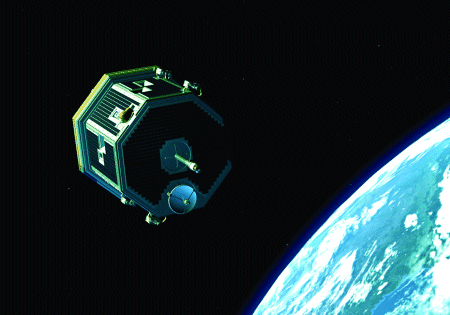TIM FURNISS / LONDON
Two parts of the $158 million spacecraft are observed 460,000km from Earth
NASA's Comet Nucleus Tour (Contour) spacecraft is believed to have split in two after an apparently successful solid rocket propellant motor firing on 15 August to send the Discovery programme probe towards its first comet target.
The $158 million Contour spacecraft was placed into Earth parking orbit after a Delta II launch on 3 July and was due to reach the comet P/Encke next year, followed by a fly-by of another comet, P/Schwassmann Wachmann-3, in 2006.
The University of Arizona observed two parts of the craft about 460,000km (286,000 miles) away from Earth after signals from Contour ceased following the firing of the Thiokol Star 30BP kick motor on 15 August. "That image was pretty discouraging," says the Johns Hopkins University's Applied Physics Laboratory (APL), which built the spacecraft. The only hope is that the craft may later transmit signals if a programmed recycle is activated.
"We can't rule out the idea that the spacecraft is still operable," APL says. The spacecraft was over 2 million kilometres away from Earth late last week.
Contour is the sixth mission in the Discovery series introduced by former NASA administrator Dan Goldin under the agency's "faster, better, cheaper" approach.
The first mission, the Near Earth Asteroid Rendezvous (NEAR), was launched in 1996 and reached the asteroid Eros, followed by an unprecedented and unplanned landing. The Mars Pathfinder and its Sojourner rover worked on the surface of the Red Planet in 1997, while Lunar Prospector found more evidence of the existence of water under the moon's poles in 1998. Launched in 1999, Stardust's mission is to collect interstellar and comet dust, which will be returned to Earth in a small capsule. Genesis, launched in 2001, will study the sun and return a capsule containing solar wind to Earth.
Contour will be followed by the Mercury orbiter Messenger; Deep Impact, which will send a projectile into a comet; Dawn, which will visit two of the oldest and largest asteroids in the solar system; and Kepler, which will be equipped with a powerful telescope to spot planets around other stars.
Two other Discovery "missions of opportunity" are planned. The Aspera instrument will study the solar wind's interaction with the Martian atmosphere aboard Europe's Mars Express, while NASA will participate in an international NetLander programme involving Mars surface craft.

Source: Flight International























